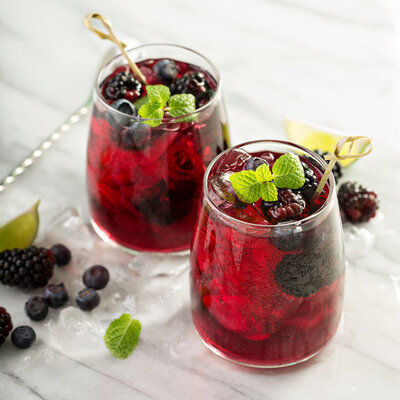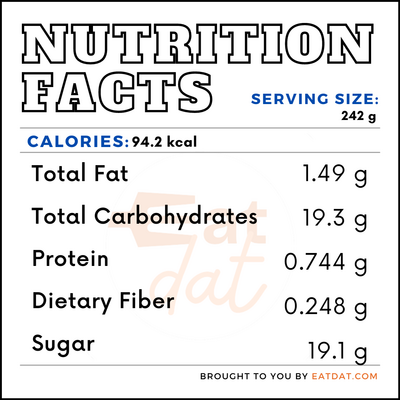
Blackberry Juice
What is Blackberry Juice?
Blackberry juice is the liquid extract of the blackberry fruit or a juicy concoction made by blending blackberries with other fruits or vegetables. The blackberry, also known as brambleberry, bramble, dewberry, or thimbleberry, is not a berry but an aggregated fruit with the juice contained in the seeds. Its juice is black in color and has a sweet taste.
- The fruit is similar in appearance to black raspberries, even though they are completely different species and can be distinguished by the fact that the latter has a hollow core.
- This is a fruit juice, but can be added to desserts and baked goods for enhancing the taste.
Apart from fruit juice, some other ways to use blackberry are:
- Baked goods
- Gelatin desserts
- Ice cream
- Pâte de fruits
- Sauce
- Compotes
- Cocktails
- Lemonade
- Milkshakes
Origin of blackberry juice
Blackberry consumption can be traced back to the Iron Age around 2,500 years ago. Ancient Romans, Ancient Greeks, and Native Americans are known to have used blackberries both as food and medicine. Also, they have been used as dyes in ancient civilizations. Anglo Saxons used the fruit to make pies for the harvest festival, Lughnasadh. They were often used as a symbol in ancient magical beliefs and superstitions. The London Pharmacopoeia documented blackberries being used to make wines in the late 1600s. Today, blackberries can grow almost all over the world, except in Antarctica.
Nutrition
Nutritional profile for blackberry juice (1 glass):

In addition, blackberry juice is rich in calcium, magnesium, phosphorus, potassium, vitamin C, folate (B9), choline, vitamin A, carotene, lutein, and vitamin K. Regular consumption can help in reducing blood pressure, lower LDL and increase HDL, as well as reduce the risk of cardiovascular diseases, diabetes, and some types of cancers such as esophageal, cervical, and breast cancers. Additionally, they can help in soothing sore throat, ulcers, inflammations, anemia, regulates menses, diarrhea, and dysentery.
Commercial production
Serbia has the largest blackberry production in the world, followed by the USA, Mexico, Hungary, and China, which account for most of the world’s production. Fresh and ripe blackberries are required to make blackberry juice because these fruits tend to wither within 3 to 4 days of picking. First, the fruits are washed and boiled in water until they are soft. Then, sugar is added and the blackberries are mashed and filtered. Finally, the juice is pasteurized and bottled.
Blackberry juice recipes
This fruit juice can give a sweet and crisp flavor to a variety of dishes. Here are some recipes:
- Blackberry Juice
- Blackberry Syrup
- Blackberry Cordial
- Blackberry Lemonade
- Blackberry Jelly
- Blackberry Kiwi Juice
- Blackberry Cake
- Lemon Blackberry Thumbprint Biscuits
FDA regulations
The Food & Drug Administration regulates all fruit juices. The FDA defines fruit juice as any beverage that contains any amount of juice derived from fruits. Companies are required to specify the exact amount of juice present in the product. Blackberry juice must have at least a 10 percent concentration of juice.
References
Mary-Linh Tran; Junior Food Editor, Everything to Know About Cooking and Shopping for In Season Blackberries, Kitchen Stories, https://www.kitchenstories.com/en/stories/everything-to-know-about-cooking-and-shopping-for-in-season-blackberries
Aghababaee, Sahar Keshtkar et al. “Effects of blackberry (Morus nigra L.) consumption on serum concentration of lipoproteins, apo A-I, apo B, and high-sensitivity-C-reactive protein and blood pressure in dyslipidemic patients.” Journal of research in medical sciences : the official journal of Isfahan University of Medical Sciences vol. 20,7 (2015): 684-91. doi:10.4103/1735-1995.166227, https://www.ncbi.nlm.nih.gov/pmc/articles/PMC4638072/
Verma, Rameshwar et al. “Rubus fruticosus (blackberry) use as an herbal medicine.” Pharmacognosy reviews vol. 8,16 (2014): 101-4. doi:10.4103/0973-7847.134239, https://www.ncbi.nlm.nih.gov/pmc/articles/PMC4127818/
